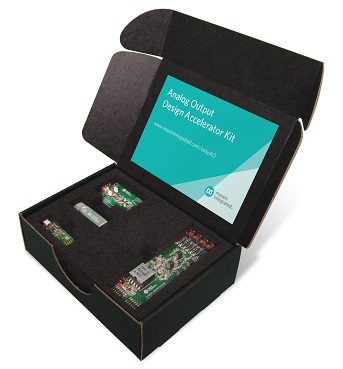Design engineers can all appreciate that using the correct tools makes our jobs both intuitive and easy, and progress, while positive, moves more rapidly every day. Reference designs are just one of those types of tools — containing the essential elements of a system available for designers to modify, enhance, and even just to learn from. Reference designs assist engineers in several ways, providing a faster time to market than going it alone, all the while cutting costs and mitigating risk.
And while the plusses of reference designs always seem to outweigh any negatives, astute designers would be advised to consider that not all reference designs make the process simple, straightforward or, once you purchase multiple boards and ancillary equipment, inexpensive.
However, reference designs do provide a solid platform for the development of next-generation products, targeting specific applications. Take, for example, the MAXREFDES24EVSYS Design Accelerator Kit, which integrates efficient power supply and accurate analog outputs in one design. The evaluation system provides everything required for engineers to evaluate their design, without the need of a bench power supply, extra lab equipment or controller boards. A quick-start guide takes designers through the ins and outs of the high-efficiency system.
The kit includes:
– Alameda (MAXREFDES24#) reference design board (Pmod™-compatible).
– USB-to-SPI adapter — USB2PMB1 — for data communication to the board.
– Universal 24-V DC power supply with international plugs and test clip adapter.
– USB-powered signal capture board, the MAXADCLITE2
– Cables for the AO reference design.
– Intuitive Windows-based graphical user interfaces (GUIs) for board communications.
– An intuitive alarm interface that demonstrates digital diagnostics capabilities of the MAX15500 output conditioners.
– Windows GUI applications that can be executed directly from the USB flash drive after USB connections are established.
At the center of the MAXREFDES24EVSYS Design Accelerator Kit is the Alameda (MAXREFDES24#) reference design board, which provides highly accurate and flexible four-channel output and scalability for multi-channel analog output modules. Configurable, it generates all typical bipolar current and voltage output ranges up to 24 mA/12 V with less than ±0.1% typical total unadjusted error (TUE). Integrated detection of power and cable faults provides diagnostics for such robust applications as industrial control.
The board houses a buffered MAX5134 4-channel, 16-bit digital-to-analog converter (DAC) that generates low-voltage signals to drive the inputs of four MAX15500 signal conditioners (output drivers). The devices communicate with the host over an isolated SPI bus and can be daisy-chained together for higher channel counts. The design also incorporates an isolated power supply circuit with a wide DC input range using a MAX17498B peak current-mode flyback controller.

This design uniquely fits in programmable logic controllers (PLC), distributed control systems (DCS), and other industrial applications.
The MAXREFDES24EVSYS bundles the reference design board with all the accessories needed for evaluation with a PC, and the board itself can still be used with a Xilinx Development Kit. The board’s compact pluggable form factor provides easy evaluation with a PC (using the MAXREFDES24EVSYS design accelerator kit) or for development using a Spartan®-6 LX9 or ZedBoard™ Xilinx-based platform.
System-level reference designs help engineers solve challenges inherent in a variety of applications. As with the MAXREFDES24EVSYS, which specifically addresses the analog output requirements of the rugged industrial environment, there are a myriad of evaluation boards and systems available in the Maxim Integrated Reference Design Center that will substantially reduce time to market.
Get more info or order your MAXREFDES24EVSYS Design Accelerator Kit today.
Advertisement
Learn more about Maxim Integrated





